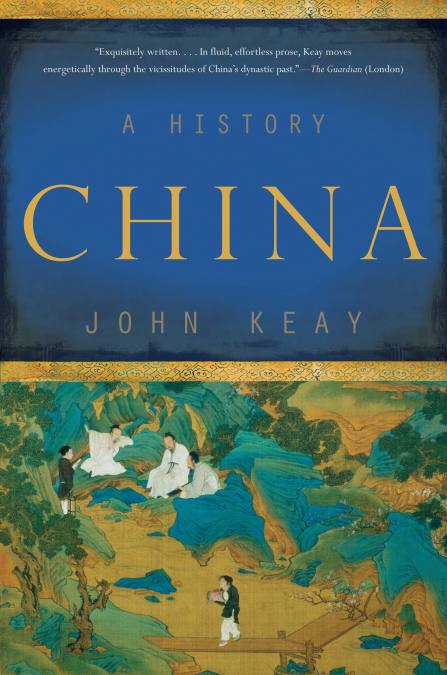Shopping Cart
China
A History
Description
An authoritative and “exquisitely written” (Guardian) account of five thousand years of Chinese history
Many nations define themselves in terms of territory or people; China defines itself in terms of history. Taking into account the country’s unrivaled, voluminous tradition of history writing, John Keay has composed a vital and illuminating overview of the nation’s complex and vivid past. Keay’s authoritative history examines 5,000 years in China, from the time of the Three Dynasties through Chairman Mao and the recent economic transformation of the country. Crisp, judicious, and engaging, China is the classic single-volume history for anyone seeking to understand the present and future of this immensely powerful nation.
Newsletter Signup
By clicking ‘Sign Up,’ I acknowledge that I have read and agree to Hachette Book Group’s Privacy Policy and Terms of Use
Praise
“Exquisitely written.... In fluid, effortless prose, Keay moves energetically through the vicissitudes of China's dynastic past.”
—Guardian (UK)“Here, at roughly 130 pages per millennium, is China's history from the earliest fragments of Xia dynasty to the last emperor, with a little of Chairman Mao added for good (or bad) luck. Its core, though, covers the 'big five' dynasties—Han, Tang, Song, Ming and Qing—from 200 BC to the start of the twentieth century, and Keay's choice is deliberate. There is no understanding China present or future without a sense of its past. Much of that past, by any standard, is awe‑inspiring.”
—Observer (UK)“Absorbingly readable.... A pleasingly cultured account of the great sweep of China's evolution.”
—Independent (UK)“Valiant, fluently written…. As Keay explains at the outset, [China’s] is a story about which we in the West know far too little….Intoxicatingly interesting.”
—Independent on Sunday (UK)“China: A History marks a welcome advance… [Keay’s] touch is deft and faithful to the tenor of the debates, especially those between archaeologists and literary scholars.”
—Philadelphia Inquirer“An epic history of China...As China begins to dominate the contemporary world order a comprehensive record of this vast nation, its extended ancestry and distinctive culture is particularly timely. There's no way of understanding China's stirring future without a sense of its awe-inspiring past.”
—Traveller Magazine (UK)“Without sacrificing substance for brevity, Keay manages to illustrate China's history very much as a narrative of the rise and fall of strong and feeble emperors, bureaucratic cliques and factionalism, the development of philosophical traditions and religious incarnations, and the constant restructuring of the empire's geographical boundaries. Readers already interested in, or wishing newly to embark upon, Chinese history will adore this book. Highly recommended.”
—Library Journal“John Keay has written...with unflagging zest, clear, accessible prose, and a refreshingly panoramic perspective.”
—Open Letters Monthly“Such a simple title, such a massive topic... In the past century alone, history books have been rewritten at least for times—to accommodate a Nationalist mythology, the Marxist dialectic of class struggle, the Maoist emphasis on proletarian revolution and the new combination of market economics and authoritarian rule. In this version, Keay acts as our guide through the maze of China scholarship and the ongoing archaeological finds that continue to make China's history an unfolding story.”
—The Age (Australia)“Keay, in this meaty, anecdotal and non-Eurocentric epic narrative, tells the sprawling story of the world's most populous nation right up to its present. The book buries into the time straddled by the various dynasties and explores the roots of Confucianism, communist, and kung-fu capitalism.”
—Hindustan Times (India)“[Keay] has done an excellent job....This is a history of political events, told with considerable skill so that it is an easy read.”
—South China Morning Post“[Keay] has produced a valiant, fluently written attempt to condense a sprawling story into a few pages... China's history, as Keay's book does a creditable job of demonstrating, is intoxicatingly interesting and its future is sure to keep us on the edge of our geopolitical seats.”
—New Review